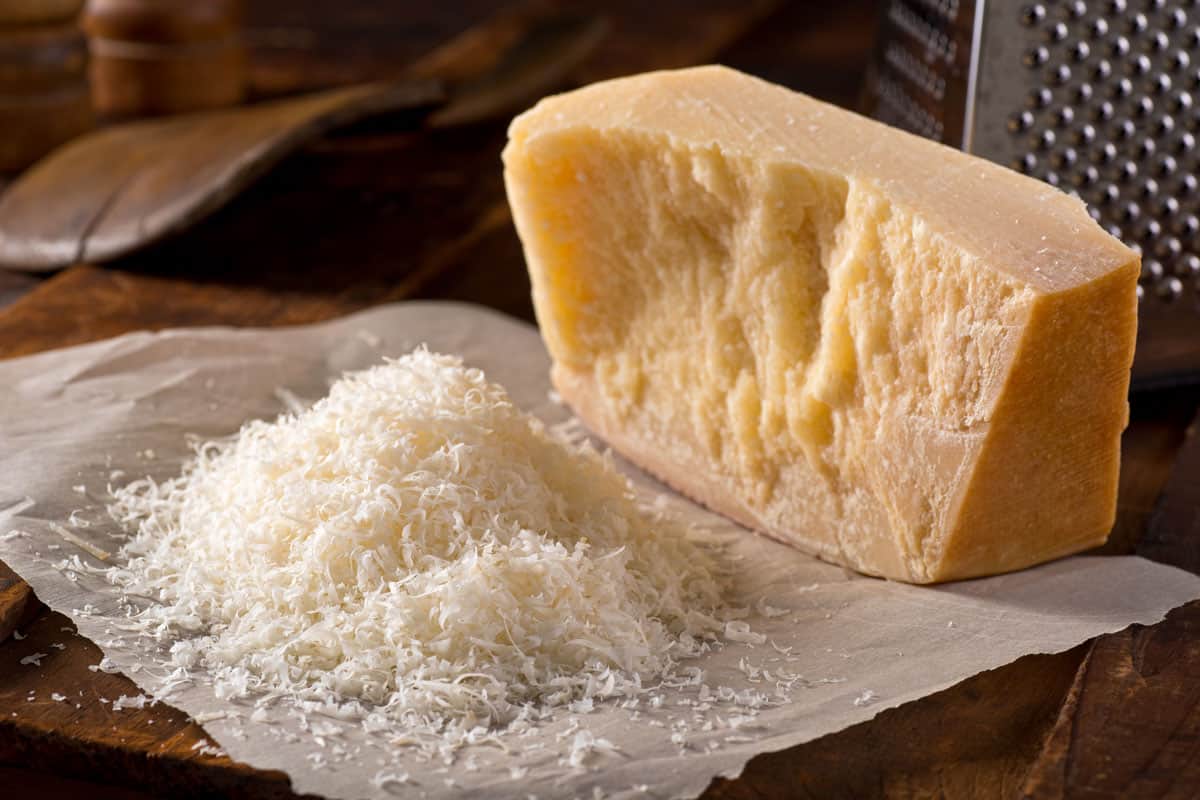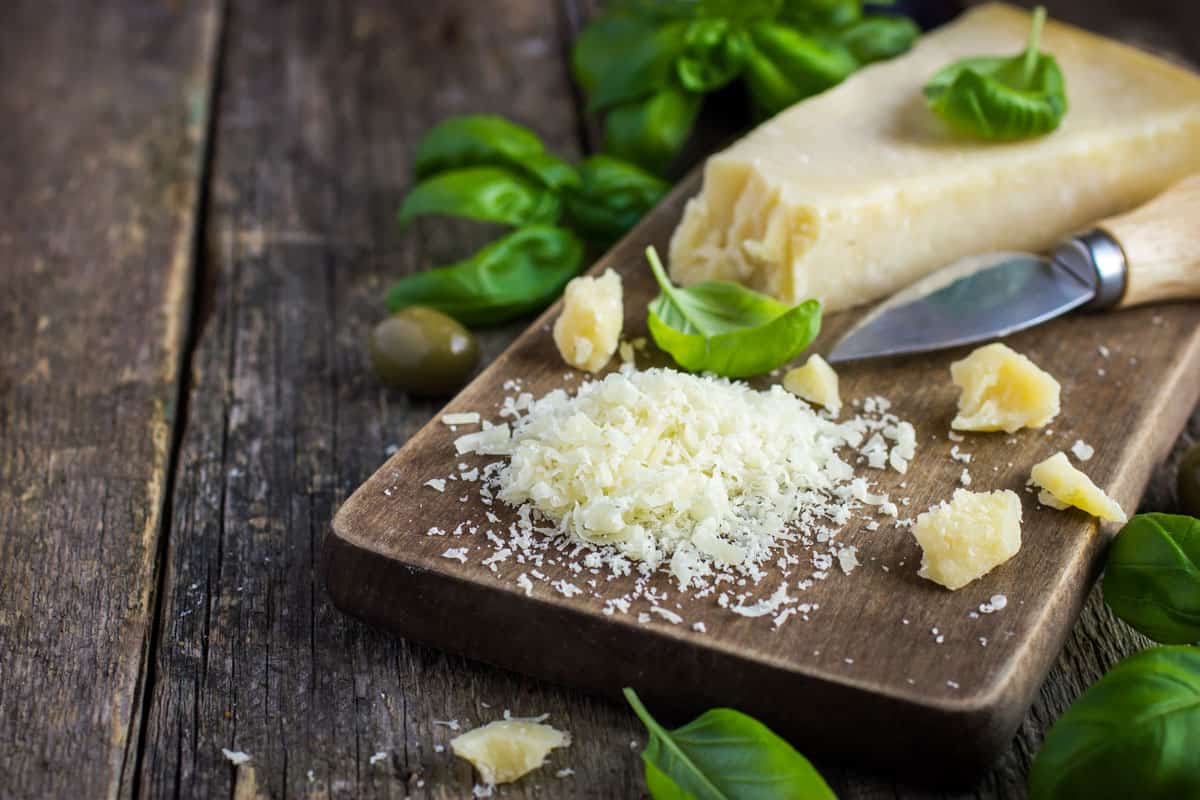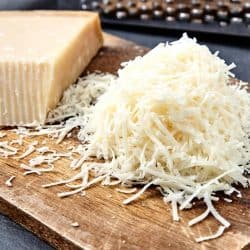![Parmesan cheese layed on chopping board for slicing with greens on the side, How to Grate Parmesan Cheese Without a Grater [5 Options Revealed]](https://kitchenseer.com/wp-content/uploads/2020/04/How-to-Grate-Parmesan-Cheese-Without-a-Grater-5-Options-Revealed-667x1000.jpg) Your latest recipe calls for grated Parmesan cheese. You have the block of cheese, but how can you grate it without a grater? No problem! We’ve tested several other kitchen utensils to find the best grater alternatives for you.
Your latest recipe calls for grated Parmesan cheese. You have the block of cheese, but how can you grate it without a grater? No problem! We’ve tested several other kitchen utensils to find the best grater alternatives for you.
Grate Parmesan cheese with any of these utensils:
- Knife.
- Zester.
- Food processor.
- Mandoline.
- Vegetable peeler.
Let’s talk about how to use these utensils for your Parmesan. And, if you have ever wondered, “What is the difference between grated and shredded cheese?” keep reading, and we’ll divulge the answer.
How do You Grate Parmesan Cheese Without a Grater?
Knife
It might interest you that specialty knives and spreaders exist for cutting and serving cheeses. A grana knife is explicitly used for Parmesan. The blade of a grana knife is shaped like an arrowhead and used to carve smaller chunks of Parmesan off large blocks and wheels.
Click here to find this grata knife on Amazon.
Most of us do not have a grana knife handy but don’t worry. Any sharp, capable blade in your kitchen will do; we suggest either a chef’s knife, paring knife, utility knife, or vegetable knife.
Click here to find this kitchen knife set on Amazon.
To grate Parmesan using a knife, carefully cut thin shards of cheese from the block. Cut those shards again, until you get tiny pieces of cheese. Some Parmesan might crumble off, and that is ok. The cheese pieces will not all be uniform when you grate with a knife. But you will make small granules of Parmesan.
Zester
A zester is commonly used to scrape the peels of citrus fruits. It is a handy kitchen utensil because it can grate not only Parmesan cheese, but other foods like spices, vegetables, and chocolate. The stainless steel edge of a zester is perforated with hundreds of holes, and each hole has a razor-sharp, protruding side.
Click here to find this zester on Amazon.
To grate Parmesan cheese, press the cheese against the protruding side of the zester and apply steady pressure. Hold the zester’s handle with your opposite hand. Now, pull the zester steadily along the cheese. Granules of Parmesan will be cut away and fall to the underside as you pull the zester.
Food Processor
Your food processor comes fully equipped to handle nearly any food preparation technique. Using the stainless steel shredding blade, you can grate Parmesan cheese.
Click here to find this food processor on Amazon.
Follow the instructions for your food processor to set-up the shredding blade. Then, slowly, feed the block of Parmesan cheese through the processor.
Mandoline
A mandoline is used for slicing, typically fruits and vegetables. It has a sharp, steel blade that can be adjusted to a range of widths for making uniform slices. Some mandolines are capable of julienning food into short strips. Others have an assortment of attachments, including a shredding blade.
Click here to find this mandoline on Amazon.
To grate Parmesan on a mandoline, first set the blade to your desired thickness. Place the block of cheese on the mandoline, and using the handguard, apply steady pressure as you push the block of cheese over the blade. If your mandoline has an edge for julienning or shredding, you can use that with the same technique.
Vegetable Peeler
A vegetable peeler typically removes the outer peel from vegetables and fruits. The stainless steel, double-edged blade strips thin layers from the surface. A vegetable peeler can be used to grate hard cheeses and other foods.
Click here to find this vegetable peeler on Amazon.
Grate Parmesan cheese by holding the block of cheese in one hand and the peeler in the other. By applying gentle pressure, move the peeler in one direction along the outer surface of the cheese. Thin layers of cheese might crumble, and that is ok because you want to achieve fine strips and granules.
How do You Grate Cheddar Cheese Without a Grater?
Because cheddar is a semi-hard cheese, softer than Parmesan, we suggest grating cheddar either straight out of the refrigerator or frozen. Chilled cheddar will keep a slightly harder texture, making it easier to grate without smashing into the utensils.
All the utensils we mentioned for Parmesan cheese should also work well for grating cheddar cheese.
Is Grated Parmesan Cheese the Same as Shredded?
In most household kitchens, the terms grated and shredded tend to be used interchangeably. Particularly when talking about types of cheese, the two techniques can even be used interchangeably. Both grated and shredded cheese melts more quickly when added to recipes, and can also be used as either a garnish or topping.
You can use a grater to achieve either effect, but technically defined by food experts, the terms grate and shred differ because each technique has a different, desired result.
- Grated cheese is fragmented into tiny, powder-like granules. Hard cheeses like Parmesan, Asiago, and Romano are typically grated.
- Shredded cheese is finely sliced into long, thin strips. Soft cheeses like cheddar, Colby, and mozzarella are typically shredded.
Other foods can also be grated and shredded. Shredded zucchini is used for baking, grated spices and zest diffuse flavor into a recipe. Either grated or shredded, toppings like coconut and chocolate can make a tasty addition to your prepared food.
Can Grated Parmesan be Used in Place of Shredded Parmesan?
Either grated or shredded, both methods will reduce the size of your block of Parmesan and should work interchangeably for most recipes. Keep in mind that grated Parmesan granules are very small so that they will cook slightly faster than shredded Parmesan strips.
As a garnish, note that when substituting one for the other, grated cheese will have a different appearance than shredded cheese. Grated cheese is fluffier, powdery in texture. Shredded cheese is stick-like, small strips of cheese.
Are you looking for tasty recipes for grated Parmesan? Check out our blog, “What Can You Cook on a Griddle?” for inspiration.
 Does Grated Parmesan Need to be Refrigerated?
Does Grated Parmesan Need to be Refrigerated?
It might come as a surprise, but Parmesan cheese does not need to be refrigerated for food safety. Parmesan is a hard cheese and will keep for as long as 6-months as an unopened block or 3-months after opening. Keep open Parmesan cheese wrapped with parchment paper between uses for best results.
Grated Parmesan will also keep unrefrigerated, according to the USDA, for at least 1-month after opening. Check the expiration date on your cheese labels to determine whether cheese should be discarded.
How Long Does Grated Parmesan Last in the Fridge?
When it is kept in the refrigerator, grated Parmesan cheese will last longer than 1-month. Always check the expiration dates on your food labels to determine if food should be discarded.
If the grated Parmesan cheese in your fridge has either a foul smell, altered color, or you see mold on the cheese, then you should discard the entire contents of the container and get new grated Parmesan cheese.
Looking for more ways to cook with cheese? Check out our blog, “Is a Double Boiler (Bain Marie) Supposed to Touch the Water?” to learn how this technique to melt cheese.








![set of cheese knives on a round wooden board. 14 Types Of Cheese Knives [Inc. What Cheese They're Good For And Why]](https://kitchenseer.com/wp-content/uploads/2021/07/set-of-cheese-knives-on-a-round-wooden-board.-14-Types-Of-Cheese-Knives-Inc.-What-Cheese-Theyre-Good-For-And-Why-250x250.png)




